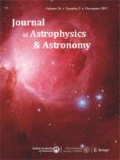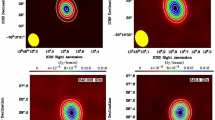Abstract
The origins of X-ray and radio emissions during an X-ray binary outburst are comparatively better understood than those of ultraviolet, optical and infrared radiation. This is because multiple competing mechanisms – emission from intrinsic and irradiated disk, secondary star emission, synchrotron emission from jet and/or non-thermal electron cloud, etc – peak in these mid-energy ranges. Ascertaining the true emission mechanism and segregating the contribution of different mechanisms, if present, is important for correct understanding of the energetics of the system and hence its geometry and other properties. We have studied the multi-wavelength spectral energy distribution of the galactic X-ray binary GRS 1716-249 ranging from near infrared (\(5 \times 10^{-4}\) keV) to hard X-rays (120 keV) using observations from AstroSat, Swift, and Mount Abu Infrared Observatory. Broadband spectral fitting suggests that the irradiated accretion disk dominates emission in ultraviolet and optical regimes. The near infrared emission exhibits some excess than the prediction of the irradiated disk model, which is most likely due to Synchrotron emission from jets as suggested by radio emission. Irradiation of the inner disk by the hard X-ray emission from the Corona also plays a significant role in accounting for the soft X-ray emission.








Similar content being viewed by others
Notes
\(L_R\) and \(L_X\) refer to radio and X-ray luminosity respectively.
The Roche lobe radius—distance of the inner Lagrangian point to the primary object (black hole)—was estimated using the following tool: http://www.orbitsimulator.com/formulas/LagrangePointFinder.html.
References
Agrawal P. C. et al. 2017, J. Astrophys. Astr., 38, 30
Anandarao B. et al. 2008, SPIE, 7014, 70142Y
Antia H. M. et al. 2017, ApJS, 231, 10
Arnaud K. A. 1996, ASPC, 101, 17
Bassi T. et al. 2019, MNRAS, 482, 1587
Bernardini F. et al. 2016, ApJ, 826, 149
Bessell M. S., Castelli F., Plez B. 1998, A&A, 333, 231
Bhalerao V. et al. 2017, J. Astrophys. Astr., 38, 31
Bharali P. et al. 2019, MNRAS, 487, 3150
Blandford R. D., Königl A. 1979, ApJ, 232, 34
Breeveld A. A. et al. 2011, AIPC, 1358, 373
Campana S., Stella L. 2000, ApJ, 541, 849
Cardelli J. A., Clayton G. C., Mathis J. S. 1989, ApJ, 345, 245
Charles P. A., Coe M. J. 2006, csxs.book, 39, 215
Corbel S., Fender R. P. 2002, ApJL, 573, L35
Corbel S. et al. 2013, MNRAS, 428, 2500
Coriat M. et al. 2009, MNRAS, 400, 123
Cunningham C. 1976, ApJ, 208, 534
Curran P. A., Chaty S. 2013, A&A, 557, A45
Dauser T. et al. 2014, MNRAS, 444, L100
della Valle M., Mirabel I. F., Rodriguez L. F. 1994, A&A, 290, 803
Dinçer T. et al. 2018, ApJ, 852, 4
Done C., Gierliński M., Kubota A. 2007, A&ARv, 15, 1
Falcke H., Biermann P. L. 1996, A&A, 308, 321
Falcke H., Biermann P. L. 1999, A&A, 342, 49
Fender R. P. et al. 2001, MNRAS, 322, L23
Gandhi P. et al. 2008, MNRAS, 390, L29
García J. et al. 2014, ApJ, 782, 76
Gierliński M., Done C., Page K. 2008, MNRAS, 388, 753
Gierliński M., Done C., Page K. 2009, MNRAS, 392, 1106
Hameury J. M. 2020, AdSpR, 66, 1004
Jiang J. et al. 2020, MNRAS, 492, 1947
Jordi K., Grebel E. K., Ammon K. 2006, A&A, 460, 339
Joshi V., Vadwale S., Ganesh S. 2017, ATel, 10196, 1
Kosenkov I. A. et al. 2020, A&A, 638, A127
Lenz D., Hensley B. S., Doré O. 2017, ApJ, 846, 38
Makishima K. et al. 1986, ApJ, 308, 635
Markoff S., Falcke H., Fender R. 2001, A&A, 372, L25
Masetti N. et al. 1996, A&A, 314, 123
Matsuoka M. et al. 2009, PASJ, 61, 999
Merloni A., Di Matteo T., Fabian A. C. 2000, MNRAS, 318, L15
Mitsuda K. et al. 1984, PASJ, 36, 741
Negoro H. et al. 2016, ATel, 9876, 1
Poole T. S. et al. 2008, MNRAS, 383, 627
Poutanen J., Krolik J. H., Ryde F. 1997, MNRAS, 292, L21
Russell D. M. et al. 2006, MNRAS, 371, 1334
Russell D. M. et al. 2013, MNRAS, 429, 815
Russell T. D. et al. 2014, MNRAS, 439, 1390
Schlafly E. F., Finkbeiner D. P. 2011, ApJ, 737, 103
Singh K. P. et al. 2016, SPIE, 9905, 99051E
Singh K. P. et al. 2017, J. Astrophys. Astr., 38, 29
Shakura N. I., Sunyaev R. A. 1973, A&A, 500, 33
Tao L. et al. 2019, ApJ, 887, 184
Taranova O. G., Shenavrin V. I. 2001, AstL, 27, 25
Vadawale S. V., Rao A. R., Chakrabarti S. K. 2001, A&A, 372, 793
Vadawale S. V. et al. 2016, SPIE, 9905, 99051G
van Paradijs J., McClintock J. E. 1994, A&A, 290, 133
van Paradijs J., McClintock J. E. 1995, xrbi.nasa, 58
Veledina A., Poutanen J., Vurm I. 2013, MNRAS, 430, 3196
Wilms J., Allen A., McCray R. 2000, ApJ, 542, 914
Yadav J. S. et al. 2016, SPIE, 9905, 99051D
Yadav J. S. et al. 2016, ApJ, 833, 27
Zdziarski A. A., Johnson W. N., Magdziarz P. 1996, MNRAS, 283, 193
Życki P. T., Done C., Smith D. A. 1999, MNRAS, 309, 561
Acknowledgements
This work was supported by Physical Research Laboratory, a unit of Department of Space, Government of India. It uses data from the AstroSat mission of the Indian Space Research Organisation (ISRO), archived at the Indian Space Science Data Centre (ISSDC). We thank the POCs of SXT (TIFR), LAXPC (TIFR), and CZTI (IUCAA) for verifying and releasing the data via ISSDC data archive and providing the necessary data analysis software through the AstroSat Science Support Cell. UVOT data were obtained from the HEASARC data archives and were analyzed using the information provided by the UK Swift Science Data Center (University of Leicester). This research has also made use of MAXI data provided by RIKEN, JAXA, and the MAXI team. SKR thanks Sushree S. Nayak for valuable feedback on the manuscript.
Author information
Authors and Affiliations
Corresponding author
Additional information
This article is part of the Special Issue on “AstroSat: Five Years in Orbit”.
Rights and permissions
About this article
Cite this article
Rout, S.K., Vadawale, S.V., Aarthy, E. et al. Multi-wavelength view of the galactic black-hole binary GRS 1716–249. J Astrophys Astron 42, 39 (2021). https://doi.org/10.1007/s12036-021-09696-5
Received:
Accepted:
Published:
DOI: https://doi.org/10.1007/s12036-021-09696-5




